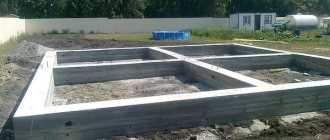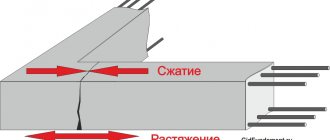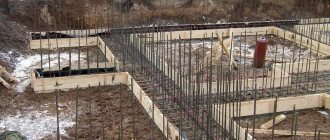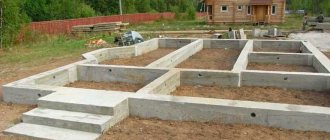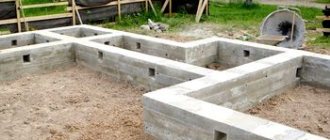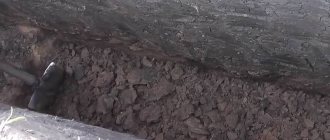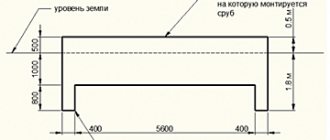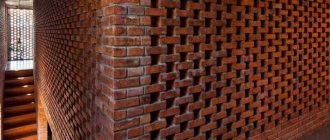Any building, regardless of its purpose, is unthinkable without a reliable foundation. Construction of the foundation is one of the most important and natural tasks of the entire construction cycle as a whole, and this stage, by the way, is often one of the most labor-intensive and costly - often up to a third of the estimate is spent on it. But at the same time, any simplifications, unreasonable savings on the quality and quantity of necessary materials, and neglect of current rules and technological recommendations must be absolutely excluded.
Reinforcement of strip foundation drawings
Of all the variety of foundation structures, the strip type is the most popular, as it is the most universal, suitable for the majority of houses and commercial structures being built in the field of private construction. Such a base is highly reliable, but, of course, with high-quality execution. And the key condition for strength and durability is well-planned and correctly carried out reinforcement of the strip foundation, drawings and basic principles of construction of which will be discussed in this publication.
In addition to the diagrams, the article will provide several calculators that will help the novice builder in performing this rather difficult task of creating a strip foundation.
Everything you need to know about strip foundations.
Experts in the construction industry classify the strip type of base as a monolithic base, but only with the exception of one, but very significant difference - cost-effectiveness and accessibility. Despite the fact that the amount of concrete solution required for the work is reduced, the foundation does not lose its strength characteristics and is particularly reliable. Today it is used for the construction of high-rise buildings, industrial and public facilities, and also, of course, in the construction of country cottages of any number of floors.
Monolithic foundation plan drawing.
Concrete selection
All industrial concrete is divided into grades. Each brand is characterized by its compressive strength. The higher the grade, the higher the ability of concrete to withstand compressive pressure when hardened. In addition to the brand, concrete also has a class. In modern construction, class is a fundamental indicator. It is by class that ready-mixed concrete is ordered for a construction site.
When constructing lightweight buildings made of wood or porous concrete, the foundation is poured with class B15 concrete, which corresponds to grade M200. Brick houses with reinforced concrete floors are erected on foundations made of concrete class B20, or grade M250. For large brick cottages with 2 or 3 floors, as well as for small industrial facilities, the foundation is made of B22 concrete (grade M300).
In regions with high humidity and severe winter frosts, concrete with high levels of moisture resistance and frost resistance is used. This is class B30 or grade M400. More durable concrete is rarely used in private construction. Sometimes it is used to pour a strip foundation for a massive building.
Read more about concrete grades for strip foundations here, and how to calculate the amount for pouring here.
Supports for strip base.
Support structures that are used for this type of foundation come in 2 varieties, namely:
- Strip monolithic foundation. The concrete mixture is gradually and evenly poured into the pit;
- Prefabricated strip foundation. In addition to the mortar, ready-made reinforced concrete structures are also used.
Prefabricated strip foundation plan drawing.
Drawing with additional drawings (large scale).
In order to determine how deep the trench should be in this case, it is necessary to be guided by a soil freezing map. It is different for each area, and if an inaccurate indicator is used during work, then such an oversight can be fraught with shrinkage of the structure or even destruction of the entire foundation. The width of the pit depends on the load that will be placed on the foundation during the direct operation of the house.
Moisture insulation of formwork
To answer the question whether waterproofing is needed for formwork or not, let’s consider its main functions. The design is designed to limit the space into which the concrete solution will be poured to form the foundation. In other words, the main function of formwork is to form a liquid solution, which, when hardened, forms the necessary geometric shape.
Waterproofing strip foundation formwork
To assemble the formwork, as a rule, wooden panels are used, which are hygroscopic. Because of this, structural elements may be deformed, which will lead to distortion of the geometric shapes of the poured concrete base. In this case, the answer to the above question becomes obvious: waterproofing for formwork is really necessary.
What types of insulators are used for finishing formwork? To protect wooden formwork elements the following can be used:
- bitumen solutions;
- hydrophobic impregnations;
- water-repellent varnishes;
- roll insulators.
When calculating the amount of waterproofing materials used, it is worth noting that for formwork processing, painting with bitumen will be the most cost-effective option.
What should be taken into account during calculations?
In order to carry out calculations correctly, it is important to consider the following characteristics:
- the weight of the future structure. To calculate this indicator, you should be guided by the total weight of the materials that will be used for construction. An important factor is the number of storeys of the structure.
- soil type. It has a direct impact on the degree of shrinkage.
- the degree of load on the foundation during the period of operation.
Foundation plan drawing.
CemFix
A highly effective accelerator is a complex additive for concrete and mortar mixtures requiring high early strength.
More details
We make the plan correctly.
When creating supports for a strip foundation, the drawing must meet the following requirements.
- When determining the most appropriate scale, it is highly recommended to choose either 1 in 100 or 1 in 400.
- Before starting construction work, the site should be marked.
- If you plan to create a house or public structure with columns, be sure to indicate this designation and section on the drawing.
- All lines on the paper must be clear and precise, the thickness of each of them is 0.5-0.8 millimeters.
In the general diagram there must certainly be a designation of the sole, as well as the places in which various bulges or depressions will be located. This is important in order to calculate the location of communications from central highways.
Plan of a strip foundation made of FBS blocks drawing.
Such holes and protrusions must be displayed on the diagram as contours and broken lines. Explanatory notes and footnotes may be provided if necessary.
Clay castle
Water can flow to the foundation not only from high groundwater or wet soil. During heavy rainfall, water flowing down the walls erodes the soil along the foundation. A clay castle and blind area are designed to protect against this.
To form a clay castle around the perimeter of the foundation, you need to dig a ditch 0.5 m deep from the outside.
The bottom layer will be a gravel-sand cushion 5 cm thick.
Before laying the clay, it must be brought to a plastic state. About the same as tight plasticine.
For convenience, in order to maintain the thickness and density of the layer, balls the size of a fist are formed from clay. These balls are laid in 2 layers, bridging the gaps, and compacted.
Difficult sections of the diagram.
If you are planning to build a capital and large-scale structure, then it will most likely require the creation of a complex prefabricated or monolithic foundation. As a rule, such diagrams cannot be contained in one drawing. Therefore, experts in the construction industry strongly recommend developing separate plans for complex areas. Alternatively, you can apply additional centerlines and section designations (if necessary) to the main plan, as well as create large sections on the sheet, having previously made a mark about this. In addition, depending on the degree of section, it is recommended to choose a scale of 1 to 20, 1 to 25, or 1 to 50, in order to get the section and complex structural elements as close as possible.
Strip foundation plan drawing.
Polypropylene fiber
Universal polypropylene reinforcing fiber for adding to the solution.
More details
Recommended composition of masonry mortar M100:
| Batch volume Component | 1 cube | 100 l | 85 l |
| Cement | 250 kg | 25 kg | 21 kg |
| Water | 140 l | 14 l | 12 l |
| Sand | 1580 kg | 158 kg | 134 kg |
| CemFix additive | 0.5 l | 0.05 l | 0.04 l |
| FIBRA CEMMIX (polypropylene) | 900 g | 90 g | 75 g |
Additions to the scheme.
If you are going to create a monolithic or prefabricated type of strip base, then, to clarify the drawings, you should accompany them with the following technical documents:
- Scheme of reinforcement of the site based on the future load of the structure on the foundation;
- An application that displays the design features of a structure;
- Advisory explanations regarding preparatory work on the site;
- Tables and diagrams that are necessary for waterproofing and thermal insulation of foundations.
- Data on load standards on foundation supports.
Strip foundation plan drawing.
Differences between an insulated monolithic Swedish slab and a video about its construction
As mentioned earlier, the insulated slab under the house developed by Swedish builders is energy-saving. During its construction, permanent formwork made of extruded polystyrene foam is used. As a result, heat leakage into the ground is minimal. The second fundamental difference is the water heated floor system built into the slab.
Since engineering systems are poured deep into concrete, it requires accurate and competent calculations. High demands are also placed on execution. Even small mistakes are critical. You can make USP yourself, but it is better to order the project. See the following photo for an approximate breakdown of costs. The amounts are no longer relevant, but the percentages are correct. The cost of the foundation project is about 1%.
In the following videos you will see the stages of making a Swedish stove for a specific house. Many useful devices are described that will make work easier, and explanations are given for some of their features.
Determination of the degree of depth.
As already mentioned, the depth of the trench to create a strip-type foundation is calculated depending on the scope of application of the supports. Today, two main types of structures are popular – deep and shallow. Once you decide which option is worth giving preference, the corresponding designation should be made on the plan.
- The first type of base is characterized by reinforced reinforcement and is an excellent choice for large structures, the design of which involves the creation of basements, attics or heavy partitions. It is believed that the most optimal indicator of the degree of deepening of a trench for a tape is an indicator that is 20-25 meters higher than the level of soil freezing depth in a particular region.
- The drawings certainly contain information about how deep the tape will be buried. It is important to remember that the amount of consumables for forming buried supports is an order of magnitude greater.
Strip foundation reinforcement plan drawing.
Additional drawing (complex reinforcement).
Vertical waterproofing methods
Vertical waterproofing is installed on concrete strip walls both outside and inside. The procedure is intended to protect the foundation from moisture, which results in the formation of mold, mildew, destruction of concrete, and frost ruptures in the massif in winter.
The most critical area is the outer side of the tape, but it is also necessary to install protection from the inside. This is necessary to prevent condensation formed on the cold surface of the foundation strip from penetrating into the concrete.
If there is a basement, then installation of waterproofing becomes a mandatory measure accompanying the organization of high-quality ventilation.
The choice of material for vertical waterproofing must be made carefully and responsibly. After filling the sinuses, access to the surface ceases, so everything must be done without mistakes.
For application to concrete tape the following are used:
- Coating compounds (mastic, heated bitumen). Recommended only for application on the outside of the tape, as they are only effective under direct moisture pressure. Application is carried out by spraying, painting or (most often) coating surfaces. It is most convenient to use ready-to-use mastic, since you have to use an open fire to heat the bitumen, which is not always possible.
- Roll materials. Traditional type of waterproofing, along with tar. The most common type is roofing felt; glassine and waterproofing are also common. Application is carried out either on a layer of hot bitumen or on mastic. Installation of the second layer can be done on the previous one by heating the material itself; the molten layer of bitumen connects the layers like an adhesive composition.
- Penetrating compounds. This type of waterproofing impregnation appeared relatively recently, but has managed to prove itself on the positive side. The compositions do not form a waterproof cut-off, but change the properties of concrete, stopping the ability to absorb moisture. There are compositions for surface application and for deep impregnation from the inside by pumping the composition into drilled holes. After application, the composition impregnates the base material, crystallizes, clogging all concrete capillaries and blocking the possibility of absorption.
When choosing the most suitable material, you should take into account the operating conditions of the foundation, the hydrogeological composition of the soil, the type of foundation and the depth of immersion. Experts recommend using penetrating compounds to obtain high-quality waterproofing of a new type.
NOTE! When applying penetrating waterproofing compounds, it is necessary to ensure proper conditions (dry surface, temperature not below zero, absence of scorching rays of the sun or strong wind), and also follow the technology of use.
Fundamental differences in support schemes.
Above, we tried to describe in as much detail as possible the process of creating a structure plan for which a strip foundation drawing is used. But at the same time, we should not forget that the drawings containing information about the prefabricated type of supports are fundamentally different from monolithic ones in that they contain a section, as well as a designation of straight and angular reinforced concrete structures.
Strip foundation plan drawing.
Correct height above ground
The section of the tape that rises above the ground level is called the plinth.
It is necessary to solve several problems:
- Raising the floor level of the first floor. The height of the plinth determines the installation plane of the ceiling, which most owners want to raise above the ground.
- Protection of wall material from contact with snow masses in winter. If the snowdrifts come into contact with the walls, the materials may become wet and saturated with water, which contributes to the destruction of the house’s structures.
- Giving the house solidity and respectability. A high base makes the house more attractive and increases its size.
Usually the height of the base is made at least (minimum value) 40 cm and above.
We carry out the calculations ourselves.
We assure you that today there is a sufficient amount of information available on the Internet in order to carry out all the necessary calculations as much as possible. To do this, it is absolutely not necessary to be an engineer or have a technical education. With a responsible approach to the issue, as well as being an observant and attentive person, you can easily calculate all the criteria necessary to create, for example, a strip foundation for a non-residential structure or a building envelope. It is important to consider the following:
- Vertical impact on the ground;
- The weight load of the main structure on the base;
- The weight of the roof and rafter system (but only if you are going to build a barn or non-residential outbuilding);
- When creating a foundation drawing, in order to eliminate errors, the results must be multiplied by “2%”. This will help protect against possible shortcomings during the independent design process.
Strip foundation plan drawing.
Will the services of professional specialists be required to create the drawing?
Of course, a plan for a strip foundation for a residential building requires much more accurate and detailed calculations, which are best left to a specialist. When contacting a master of his craft, you can be sure that the drawing will:
- easy to read;
- as accurate as possible;
- meeting all SNiP requirements;
- containing comprehensive information about the preparatory work;
- having, in addition to the main drawing, technical applications in the form of various tables, diagrams, etc.
Strip foundation formwork plan drawing.
In this article, we tried to provide comprehensive information about the process and principle of creating a drawing of a strip foundation for residential as well as non-residential structures. And remember that if you are not confident in your abilities, then do not try to carry out the calculations necessary for such a basis on your own or using unlicensed programs. Saving in this case can be fraught with huge losses or even the destruction of the entire building or fence.
How to make a foundation drawing?
At the initial stage, it is necessary to determine the dimensions of the building, obtaining the four axes of the external walls. Then the axes of internal load-bearing walls and heavy partitions are added to the project, taking into account the following factors:
- enclosing structures must withstand the weight of cladding, ceilings, rafter system, roofing
- When choosing a wall material that needs protection from getting wet and solar ultraviolet cladding, it is more rational to use a ventilated façade with insulation inside it.
- then all loads on the foundation and the soil underneath are collected (the weight of structural, cladding materials of the roof, ceilings, walls, wind and snow loads)
- after which, you can calculate the width of the sole
Then on the sketch it is enough to add two lines (inside, outside the perimeter) from the axes of the strip foundation. The formwork panels will be mounted along these cords; the string along the axial lines will make it possible to control deviations in the geometry of the monolithic foundation.
Plan of a monolithic strip foundation drawing.
The simplest design method.
When calculating individual elements of a strip foundation , tables SP 22.13330 or V. S. Sazhin’s Guide will be required. The technology for calculating the width of the tape is as follows:
- prefabricated load calculation
- soil determination visually or by rolling into a rope
- dividing the resulting figure by the calculated soil resistance taken from the tables for specific soil on the site (minimum value to compensate for possible errors)
Strip foundation plan drawing.
The burial depth for MZLF is 0.3 – 1 m depending on the groundwater level. Recessed strips are lowered below the freezing mark by 0.4 - 0.6 m. The height of the basement part of the foundation depends on the preferences of the developer:
- by pouring the tape at 10 - 20 cm from the ground level, you can create a floor on the ground, sharply reducing the construction budget
- when lifting by 40 - 60 cm, a ceiling on beams or a slab is used; ventilation vents are required in the basement
- if an underground floor is planned, the height of the basement depends on the level of the finished floor in it
Based on the calculation results, it is possible to prepare a drawing for moving the axes to the building site and carrying out excavation work.
Sketch of a strip foundation.
To accurately draw a monolithic foundation, you need access to professional graphic editors AutoCAD, Compass, Solid Work, Archikad. Therefore, paper sketches are often used for garden buildings. On it it is necessary to mark the axes of the walls, auxiliary structures (stove, internal staircase, porch, fireplace), and draw the contours of the foundation strip.
Reinforcement scheme.
Foundation plan drawing how to draw.
For any strip foundation, reinforcement is necessary if it is planned to manufacture a monolithic structure on site. The layout of the lower and upper reinforcement frame can be depicted in the same drawing. You will need it to draw up estimates when purchasing rods, wire, spacers, and stands. When drawing a diagram, you must consider:
- It is prohibited to overlap the rods in the corners; the reinforcement is bent at right angles and overlapped on the adjacent side of the tape
- when extending rods along the length, the overlap should be 60 - 70 cm
- in wall joints, the rods are joined similarly to the corners (bending, launching to the adjacent side)
- the protective layer (distance from the concrete surface to the reinforcement) is 1.5 – 4 cm
Strip foundation reinforcement plan drawing.
When the belt width is less than 15 cm, one rod in each belt is sufficient. In wide tapes, the minimum distance between the rods (in the clear) should be more than 35 mm (bottom), 40 mm (top). Reinforcement is needed in the lower part at the sole, near the upper edge of the structure. In the middle part, the tape is reinforced only when it is high (from 0.7 m).
Connecting fittings to each other
In addition to overlap welding, it is also possible to overlap reinforcement bars using tie wire. To do this, the rods must be connected with an overlap of at least 30 diameters, and the distance between the centers of such joints must be at least 65 diameters.
The joints of the reinforcement should be staggered so that there are no joints of adjacent bars at the same level.
According to SNiP, at the intersections of the reinforcement, it is also necessary to fasten the rods together with tying wire or ties. It is allowed to knit only 50% of the joints in a checkerboard pattern
This is especially important when knitting reinforcements, when there are not just a lot of such joints, but a catastrophic number and the workers begin to slack. All ends of the rods must be knitted without exception. In seismic areas such as the Krasnodar Territory, all joints must be knitted
In seismic areas such as the Krasnodar Territory, all joints must be knitted.
Reinforcement of adjacent connecting structures at corners is the weakest point in reinforcement. Hack workers or simply illiterate workers simply overlap reinforcement bars into a sort of mesh. But corners are not reinforced this way! With such reinforcement, the walls seem to work separately instead of working together, and cracks appear in the corners of the foundation.
Curved elements are used in corners, openings, and edges of structures. According to the rules of both SNiP and the American Concrete Institute, reinforcement can be bent at an angle of 90 degrees on a mandrel of at least 5 rod diameters with a thickness of up to 26 mm; large rods can be bent on a mandrel of 8 diameters. The free bending end of the reinforcement must be at least 12 diameters. You cannot bend reinforcement, one end of which is embedded in concrete. Well, in private construction you won’t find 25 reinforcement, so this is more of a theory.
The hacks find a way to deceive here too - they heat the rods over a fire, autogenous, for easier bending. Some even file with a grinder. As you yourself understand, such reinforcement is no better than laying it in a “mesh”.
Construction technology.
For a monolithic foundation, a standard construction methodology is used, consisting of the following stages:
- full-scale axle offset
- trench/pit excavation
- filling the foundation cushion
- sole waterproofing
- installation of formwork
- reinforcement
- concreting
- surface waterproofing
To reduce heaving forces, the blind area and the side surface of the tape are insulated, and drains are laid at the level of its sole. At each stage there are nuances that make it possible to reduce the amount of work and increase the service life of the structure.
Marking, pit.
Before moving the axes into the construction site, it is necessary to place the building on the site for normal operation of engineering systems, fertile soil, and the dwelling itself. For example, there is often parking on the street side; an external sewage septic tank requires periodic emptying, so it is also located closer to the street. It must be at least 4 m away from the foundation to ensure a sanitary zone.
Strip foundation plan drawing.
Power transmission poles and wells with shut-off valves for connection to central life support systems are also installed here. The front facade is most often turned towards the roadway. After this, it is enough to mark the strip foundation according to the scheme:
- first wall – starting corner 3 m from the boundaries of the site, spine 5 m from the red line (street road)
- side walls - perpendicular to the first axis (construction of a triangle with 4.3 m legs, 5 m hypotenuse)
The corners of the last wall (the rear facade of the house) are obtained automatically. During excavation work and the manufacture of the foundation pad, the cord must be periodically removed. To avoid repeated measurements, castoffs are recommended - a horizontal block between two pegs. You need 2 of them for each axis; three strings can be pulled across wide slats at once (the side edges of the foundation, the axis of the wall).
Cushion, formwork.
The layer of non-metallic material under the bottom of the monolithic foundation is intended to replace heaving material and level the bottom of the trench. The most popular underlying scheme is:
- sand 20 cm + crushed stone 20 cm – laid on geotextiles, wrapped with it on top after compacting every 10 cm
- crushed stone + sand (the thickness is similar) is a more convenient option; an extra layer of geotextile is added between these materials, but there is no need to fill the footing when laying roll waterproofing
- sand 40 cm or crushed stone 40 cm - the first option only for low groundwater levels, the second for high groundwater
Rolled waterproofing (usually hydroglass insulation) is laid in 2 - 3 layers with a release so that after concreting it can be rolled onto the side edges of the tape. The formwork is mounted on top of it; it is better to use materials that can be reused (OSB, plywood, edged boards).
Vertical panels, the height of which is 5 cm greater than the design mark, are supported against the sides of the trench, the ground, and fastened with jumpers (pins, bars). In the underground level it is necessary to leave openings for the introduction of engineering systems, in the basement part of the ventilation duct. To do this, pipes are passed through the shields, which remain in the concrete for sleeves or are pulled out when stripping.
Strip foundation formwork plan drawing.
Reinforcement, filling.
The aromatic frame of a strip foundation is usually two-level. For light buildings, two corrugated rods in the upper chord and two in the lower are sufficient. To fix the rods inside the formwork, rectangular clamps are used, curved from smooth 6-8 mm reinforcement, to which longitudinal reinforcement is tied with wire. The main requirements are:
- spacing of joints in adjacent rows by 60 cm minimum
- bend at the corners
- overlap from 60 cm
Strip foundation reinforcement plan drawing.
The bottom bars rest on polyethylene supports or concrete pads to provide a protective layer. pouring occurs according to standard technology with compaction along a ring of every 60 cm of concrete to remove air.
Waterproofing, drainage.
For a monolithic foundation . partially or completely immersed in the ground, protection from moisture is necessary. This is done in several ways:
Strip foundation waterproofing plan drawing.
- waterproofing the outer edges of the tape - penetrating products, coating with bitumen mastic, gluing with Gidrostekloizol or the last two options in combination
- drainage system – placed around the perimeter at the level of the tape sole
Foundation pit plan drawing.
A storm drain (storm inlets + surface gutters) is built into the outer perimeter of the blind area, with the help of which melted rainwater is drained.
The above technology is suitable for strip foundations of any type, deepening. Recommendations from experts will help avoid mistakes and reduce the labor intensity of construction operations. The housing will have a high service life, despite independent calculations.
Roll waterproofing
The use of rolled building materials can serve as both a separate type of construction work and as additional protection for the method described above.
Waterproofing the foundation with rolled materials is carried out using the following technology - on a mastic-coated surface, cut to size (with a small margin) sheets of rolled building material are applied. The work is done from top to bottom.
Before installation, the cut sheets must be rolled, leaving the top edge for heating. Using a burner (flute), the edge of the roofing material is heated and glued to the surface of the foundation. Next, gradually unwinding the roll and heating it, glue the entire sheet, smoothing it from the center to the edges. The next sheet is glued with an overlap of 7–15 cm onto the previously installed sheet.
When gluing two or more layers, the rule of dressing building materials is observed - the seam (joint) of each subsequent layer should be 20-40 cm from the seam (joint) of the bottom of the underlying layer.
All corners of the foundation are additionally armored with strips of the same rolled material, the sides of which extend 20-30 cm on each side of the corner.
Waterproofing a strip foundation in this way requires the use of an open flame, and therefore requires compliance with safety precautions: the use of a special burner, a proven propane gas cylinder, the use of personal protective equipment (goggles, overalls, gloves and shoes).
Advantages:
- durability, up to 60 years;
- availability;
- easy maintainability;
- cheapness.
Flaws:
- not performed individually (requires a team of 2 - 3 people);
- working with open flame.
General information.
The foundation in the concept of construction is the underground part of the building (structure), which receives loads and transfers them to the base. If you look at the drawing of a monolithic base, you can highlight the following parts. The base is layers of dense soil. The upper plane on which the above-ground parts of a structure or building are located is called the edge or surface. Its lower plane, which is in direct contact with the base, is called the sole.
Residential building foundation plan drawing.
The tape is laid around the perimeter of the building.
A strip foundation is a strip of reinforced concrete that runs along the perimeter of the entire building. The tape is laid under all external and internal walls of the building. The construction technology is quite simple compared to pile or slab construction. To build a strip foundation, a drawing is required. Such a foundation is labor-intensive and requires a considerable consumption of materials compared, for example, with a columnar type (more concrete, formwork; you will definitely need to use a crane).
Tape can be used:
Strip foundation plan drawing.
Strip foundation diagram
- In houses with concrete, brick and stone walls (the density of which is more than 1000-1300 kg/cub.m).
- For houses with heavy floors (precast reinforced concrete or monolithic, metal).
- If there is a threat of uneven precipitation due to heterogeneity of soils on the site (for example, the site in one part is composed of sands, and in the other - heaving loams). A reinforced strip base can work as a single whole, redistribute forces, and then the walls of the house will not cause deformation or cracks.
- If you plan to have a ground floor or basement in the house and the walls of a similar strip structure will form the wall of the basement.
In the process of planning the construction of a house, it is quite important to competently and responsibly approach the choice of the type of structure being manufactured, because this element is one of the most important structural elements for construction. An error at the beginning of construction, saving building material, an incorrectly designed structure, or an incorrect drawing will lead to serious negative consequences during the operation of the house.
Strip foundation plan, section drawing.
Structures: a, b) prefabricated, c) monolithic, d) rubble.
Problems may arise such as distortions, excessive consumption of materials, horizontal and vertical deformations, uneven settlements, cracks in supporting structures, and so on. To a great extent, a large number of qualities of the building will depend on reliability, in addition to its durability and capitality.
It should be remembered that the zero cycle of building a building is a somewhat expensive process, and most often it accounts for a third of the cost of the entire building. It is best to order a project and drawing from experienced designers. It is worth understanding that you can ask them only if you draw up the contract correctly. The organization in the project can reasonably and competently choose the type and material with which the foundation can be made.
Features of the work
Waterproofing work to protect the foundation must be carried out during its construction, but if this condition is not met, it is allowed to carry it out later, although this will be much more difficult.
You will have to dig out the entire foundation, working in sections, so as not to reduce the level of strength of the building. Start from the corners and complete waterproofing on sections of the walls. It is better to combine vertical and horizontal types, alternating the sequence when applying the next layer.
Having excavated the foundation, we clean the base; it is not recommended to use water. Remaining soil is cleaned from seam areas and cracks.
The recesses on the foundation are filled with cement mortar or tile adhesive, then these areas are treated with bitumen mastic. Roofing felt material is fused, which will require a burner. The first layer is applied horizontally, overlapping the strips. The second layer of roofing material is fused vertically. The heat-treated strips adhere perfectly; the roofing felt at the corners of the house is not cut, but rolled up.
Simultaneously with the application of waterproofing, drainage is arranged and the blind area is poured.
